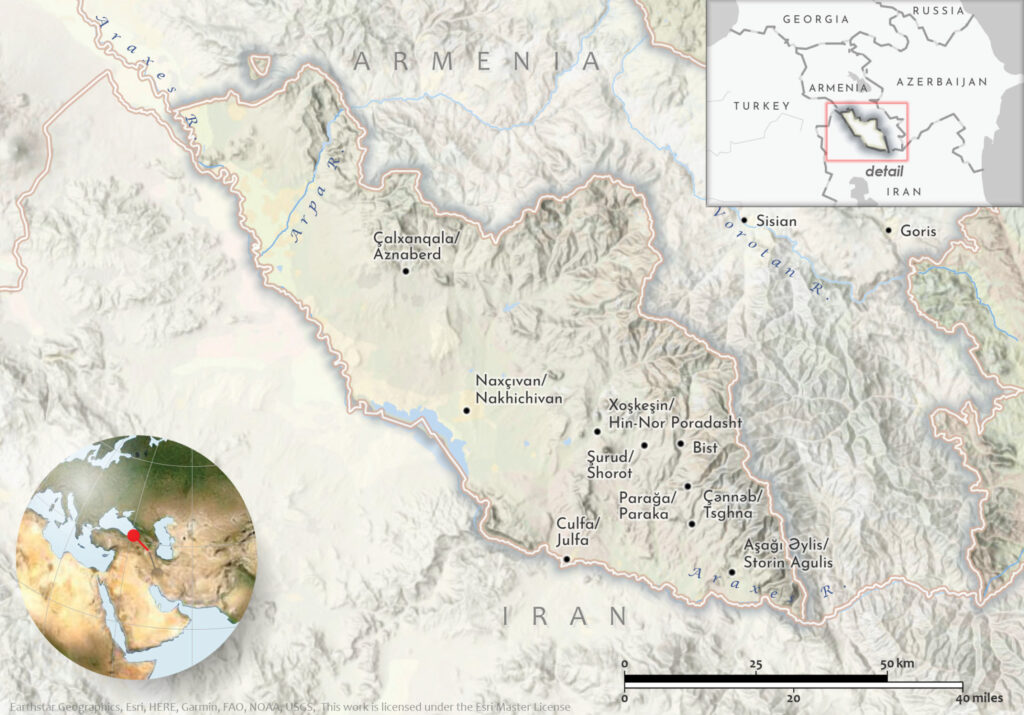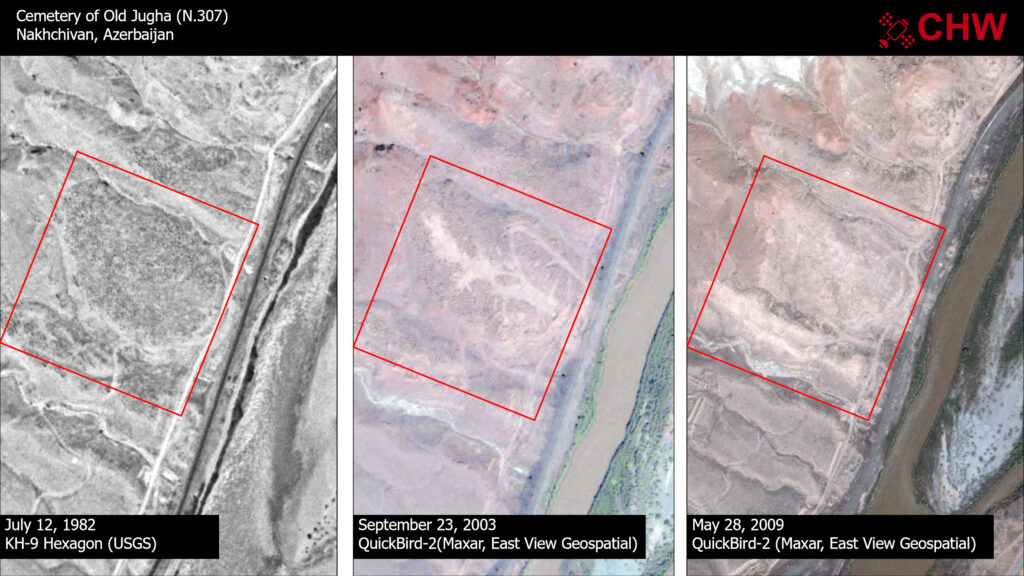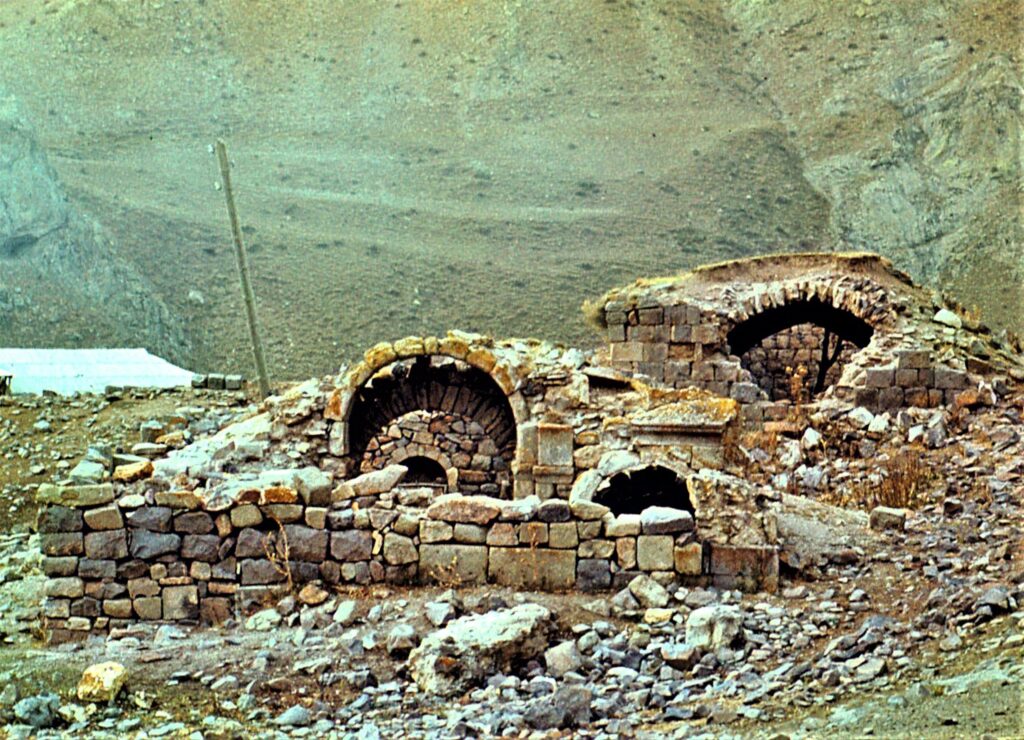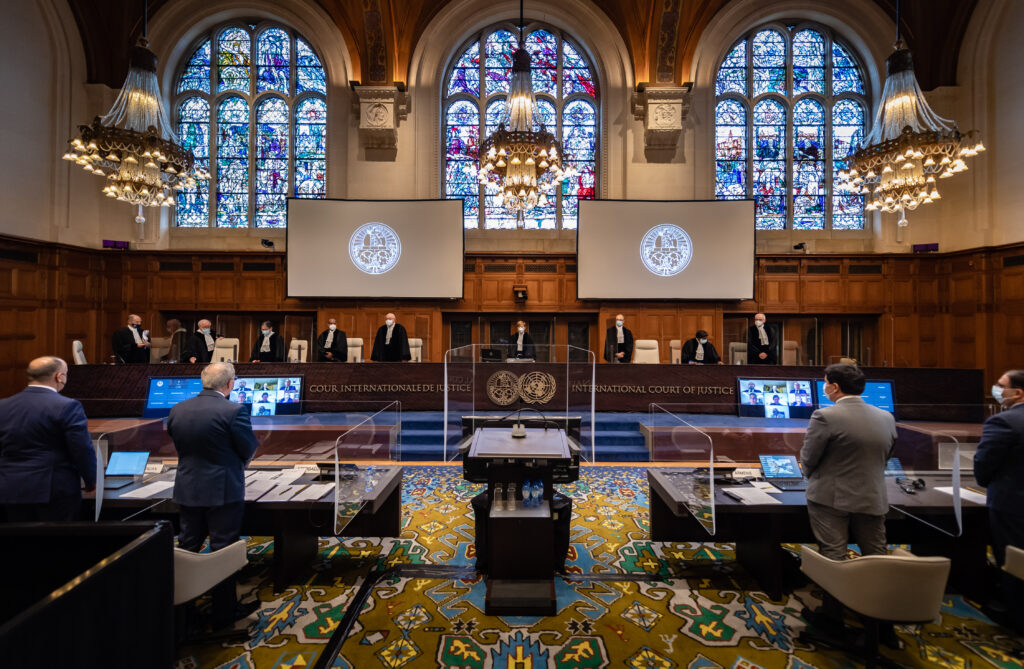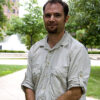Heritage Forensics Is Tackling Devastating New Forms of Cultural Erasure
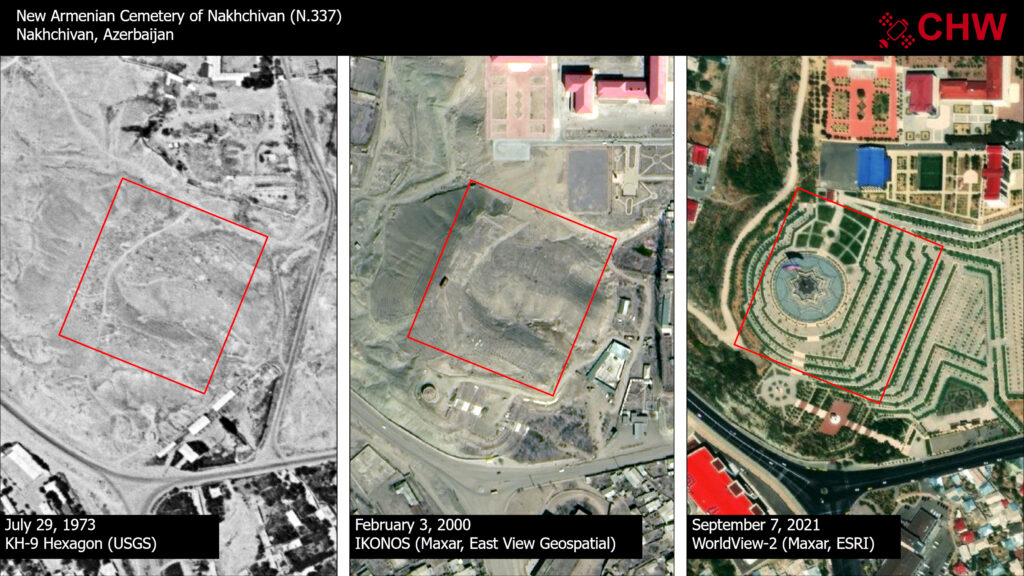
Atop the tallest hill in Nakhchivan city, the capital of the Nakhchivan Autonomous Republic of Azerbaijan, stands a rhapsodic monolith to the nation-state. The Square and Museum of the National Flag is reached by a grand stairway that rises across terraces of orderly, geometric landscaping. The museum exhibits the paraphernalia of the state—historic flags, coins, and maps—while atop the square waves an enormous Azerbaijani flag. It is a blaring monument.
But like so many repositories of national memory, this complex is haunted by the deafening silence of injustice.
The Square and Museum of the National Flag occupies land that was once a cemetery where Armenians buried their dead from the 18th to the 20th centuries. The cemetery was simply erased, one victim of a wide-reaching state-organized program of clandestine cultural destruction that has eradicated almost every trace of the Armenian communities that for centuries also regarded Nakhchivan (or what Armenians call Nakhichevan) as home.
Wedged between Armenia, Iran, and Turkey, Nakhchivan is an isolated and mountainous exclave that few foreigners are permitted to visit, a place where bearing witness to injustice demands new ways of seeing.
Our research initiative, Caucasus Heritage Watch (CHW), uses satellite imagery and other tools of heritage forensics to witness covert programs of cultural erasure at work. We recently released a 430-page report detailing the complete annihilation of 108 Armenian monasteries, churches, and cemeteries in Nakhchivan between 1997 and 2011. That means a staggering 98 percent of the Armenian heritage sites that we were able to locate and assess were obliterated.
The medieval and early modern monuments we documented were not simply ruined; they were purposely scrubbed entirely from the landscape and from official history. If such techniques of heritage erasure were to proliferate as a new tactic of national myth-making, countless irreplaceable monuments of the human past could be at risk around the world.
But newly available data, imaging technologies, and a renewed willingness on the part of archaeologists to throw themselves into the maelstrom of conflict are now providing opportunities to bear witness to heritage destruction. And also to intervene.
THE MAELSTROM OF THE CAUCASUS
The roots of the conflict between Armenia and Azerbaijan reach deep into the region’s complicated history of both fractious rivalry and peaceful coexistence. But its most proximal causes lie in the violence that erupted in the USSR’s waning days and the independence movements of the late 1980s and early 1990s that reshaped the Soviet Socialist Republics of Armenia, Azerbaijan, and Georgia.
Amid the chaos of complete political, economic, and cultural collapse, independent republics emerging from Soviet control sought to preserve their territorial integrity in the face of ethnic minorities now able to voice their aspirations for self-determination. Moscow faltered, and the international community was embarrassingly unprepared for the violence that followed. Much blood was shed. In Nagorno-Karabakh, a disputed region within Azerbaijan, Armenia and Azerbaijan fought a devastating war that resulted in an estimated 25,000 dead and more than 1 million refugees.
In 1994, a ceasefire brought an end to active hostilities in Nagorno-Karabakh, leaving Armenian authorities in possession of the enclave and calcifying the territorial dispute into what many observers classified as a “frozen conflict.” But this was largely an illusion. Between the 1994 ceasefire and the renewal of active fighting along the line of contact in 2016, the ceasefire had been breached more than 7,000 times.
What seemed from the outside to be a cold war was rather a sublimation of hostilities into new forms of violence—some at the line of contact, others far from the front. Beginning in 1997, aggression in Azerbaijan was channeled into the program of covert cultural erasure in Nakhchivan. Amid the government’s denials and falsification, the destruction waged by this program can only be fully assessed using new methods: the technologies of heritage forensics.
HERITAGE FORENSICS EXPOSES A NEW KIND OF DESTRUCTION
The image of heritage destruction that has become ingrained in the popular media over the last two decades is one of spectacular devastation. It is an image of colossal Buddhas dynamited, museums pillaged, and archaeological sites looted and bulldozed—all broadcast around the globe through mass media. Such attacks elicited global protest. However, because of their visibility, they did not require a new kind of archaeology.
CHW’s investigation of heritage destruction in Nakhchivan has documented an alternative, far more devastating form of cultural erasure. It is silent rather than spectacular. It is total instead of opportunistic. It is implemented through the bureaucratic machinery of state policy.
This kind of undercover erasure demands a forensic response—an approach to heritage that can document destruction, anticipate new threats, and contribute to deterrence.
Heritage forensics deploys advanced technologies such as remote Earth observation and immersive architectural modeling to investigate abuses of cultural sites. It produces evidence that can be used in a court of law or by civil society institutions seeking truth and justice. As a form of humanist activism, heritage forensics opens opportunities for archaeologists to intervene in heritage conflicts, especially in contexts of both state and non-state violence, war, genocides, terrorism, and totalitarianism.
Heritage forensics, unlike many forms of research, is public-facing. It is archaeology in the maelstrom.
aerospace TECHNOLOGY reveals cultural erasure
In our report on heritage destruction in Nakhchivan, CHW used declassified Cold War American reconnaissance imagery and Soviet topographic maps to geolocate 127 Armenian monasteries, churches, and cemeteries. We also used the invaluable scholarship and photo archive of historian Argam Ayvazyan, an intrepid Armenian researcher who, at great risk, documented the Armenian cultural heritage of Nakhchivan in the Soviet years. Ayvazyan’s works, used in combination with the available imagery, allowed us to assess the condition of 110 sites. All but two had been razed, their construction materials removed, and the sites scrubbed of all vestiges of the monuments they once hosted.
At St. Nshan Monastery, founded by Armenian monks in the 13th century, satellite imagery shows the structure partially intact in 1982. At the time, Ayvazyan was able to study the monument and reconstruct the plan. A 2003 image captures the site in the process of demolition. Parts of a wall remain, and debris piles dot the site. By 2009, this evidence had been removed, as if the monastery never existed. In places where such a fiction was hard to maintain, such as the large medieval Armenian cemetery at Jugha (Julfa in Azerbaijani), military facilities were erected as a pretext for denying entry to observers.
In most cases, the land on which Armenian monuments once stood remains a vacant plot. But in several instances, new civic buildings were erected atop the foundations of an erased Armenian site, such as the Square and Museum of the National Flag. An American reconnaissance satellite image from 1973 provides a clear view of the “New Armenian Cemetery” that once covered the hill. In addition, Soviet cartographers marked the cemetery on topographic maps from the 1940s to 1990. Ayvazyan recorded roughly 1,000 tombstones during his fieldwork from 1964 to 1987, approximately 400 of which bore Armenian inscriptions. But a satellite image from 2005 shows only a solitary truck atop the cemetery’s flattened and graded terrain. Freshly scoured by bulldozers, this burial ground now bears the scars of trauma, violence, and hatred.
In addition, the 17th-century Armenian sacred site of St. Hovhannes Church of Berdak was razed between 1997 and 2000, and replaced in 2019 with the Allahshukur Mosque. More than heritage appropriation, such episodes of rebuilding represent an extension of heritage violence beyond erasure to eradicate even the ghostly emptiness that haunts vacant places.
Also striking are the numerous instances in which bulldozers were deployed to already abandoned and crumbling villages to surgically remove an Armenian cultural heritage site. For example, the remote village of Nerkin Ankuzik (in Armenian, or Anzur in Azerbaijani) had long been deserted when bulldozers came to demolish a single target: an Armenian church. Built in the 11th or 12th century, the Church of Nerkin Ankuzik was poorly preserved in the 1970s, according to declassified KH-9 Hexagon imagery and Ayvazyan’s documentation of the basilica. But sometime between 2001 and 2009, the remaining walls were knocked down, the foundations were removed, and any memory of the structure was wiped from the site.
In this bureaucratic program to revise history, even ruins are not spared.
Our next work of heritage forensics focuses on the treatment of Azerbaijani cultural heritage sites in Nagorno-Karabakh while under Armenian administration. Unlike in Nakhchivan, thus far our findings show no evidence of a coordinated systematic program of cultural erasure during 30 years of Armenian control. They do indicate a failure of stewardship on the part of Armenian authorities to protect mosques, mausolea, and historic cemeteries.
The Azerbaijani heritage of the region has suffered losses due to vandalism, desecration, the stripping of materials, and in some cases, outright destruction. However, in many areas, monuments have been left fully intact. But the difference between failed stewardship and a ruthless state-led program to expunge the very memory of an adversary reveals two starkly different approaches to heritage politics.
FUTURE THREATS TO CULTURAL HERITAGE
In the aftermath of the Second Nagorno-Karabakh War of 2020, CHW has been monitoring Armenian heritage sites in Nagorno-Karabakh. The ceasefire transferred hundreds of Armenian monasteries, churches, chapels, and cemeteries to Azerbaijani administration. CHW began tasking satellites to provide regular imaging of sites that we, and a host of other scholars, deemed at risk.
We were not wrong. Since April 2021, we have documented six sites destroyed, seven damaged, and 17 under serious threat.
Our 2021 reports were admitted into evidence at the International Court of Justice (ICJ) in a suit Armenia brought against Azerbaijan under the terms of the Convention on the Elimination of Racial Discrimination. Among other issues considered in the case, Armenia asked the court for a provisional measure to require Azerbaijan to protect Armenian cultural heritage sites under its control.
Traditional global institutions of heritage protection are ill-suited to countering state-sponsored cultural erasure.
In December 2021, the court ordered Azerbaijan to “take all necessary measures to prevent and punish acts of vandalism and desecration affecting Armenian cultural heritage.” This appeared to be an important win for heritage preservation.
But in the summer of 2022, we documented something new. Our analysis picked up the complete demolition of the 18th- or 19th-century Armenian church of St. Sargis in the village of Mokhrenes/Susanlyq. The destruction of St. Sargis is the first major violation of the ICJ’s ruling we have detected. It is unclear at present whether this represents an isolated case, a pattern of violations, or a trial effort to see if the international community is paying attention.
In any case, it is vital that global heritage institutions understand that when the targets of heritage erasure are selected out of ethnic hatred, the struggle for heritage protection in this context is inseparable from a struggle for racial justice. Holding the perpetrators accountable and deterring future acts of ruination will require new approaches and new collaborations.
The annihilation of Armenian heritage in Nakhchivan highlights a devastating new model of cultural erasure. Driven by an exclusionary political ideology, it embeds heritage destruction in the policy of the state. The government’s institutions are enrolled to ensure that the obliteration is total, secret, and denied.
However, our report also demonstrates the fragility of state-sponsored historical revisionism. Representatives of Azerbaijan’s government maintain that there were never Armenians in Nakhchivan, so there is no heritage and, therefore, no cultural erasure. Decades of satellite imagery, plus historical and ethnographic documentation by Armenian scholars like Ayvazyan, easily unravel this official fiction.
Traditional global institutions of heritage protection are ill-suited to countering state-sponsored cultural erasure. UNESCO was designed as an instrument to serve the interests of nations that have accepted the U.N.’s treaties. As a result, it has few levers to discipline state parties bent on destroying cultural heritage within their own territorial boundaries. Although the ICJ’s intervention in the conflict between Armenia and Azerbaijan is a welcome new avenue for heritage protection, it, too, is a body for state-to-state jurisprudence.
The world’s stateless peoples, such as the Uyghurs, whose heritage is also under assault by a clandestine program of cultural erasure in China, have no recourse. The International Criminal Court (ICC) has also emerged as an important new institution for prosecuting acts of heritage destruction since the 2016 conviction of Ahmad Al Faqi Al Mahdi for attacking nine mausoleums and one mosque in Timbuktu, Mali. The ICC opens new routes to holding accountable violators who previously seemed to be beyond the reach of international law.
To be effective in thwarting 21st-century forms of cultural erasure, these institutions need help. Heritage forensics provides critical evidentiary material built on trusting relationships with local partners, deep engagement with scholarship in regional languages, and the research sensibility of public archaeology.
This is just one element of what will have to be a broad, coordinated effort that joins academic researchers with lawyers, stakeholders, government agencies, and civil society organizations. Such coalitions would combine a battery of skillsets to deter attacks on heritage—and to document and prosecute abuses when deterrence fails. The work of heritage forensics thus summons a publicly engaged and activist archaeology as a partner in the wider global struggle against authoritarianism.

































